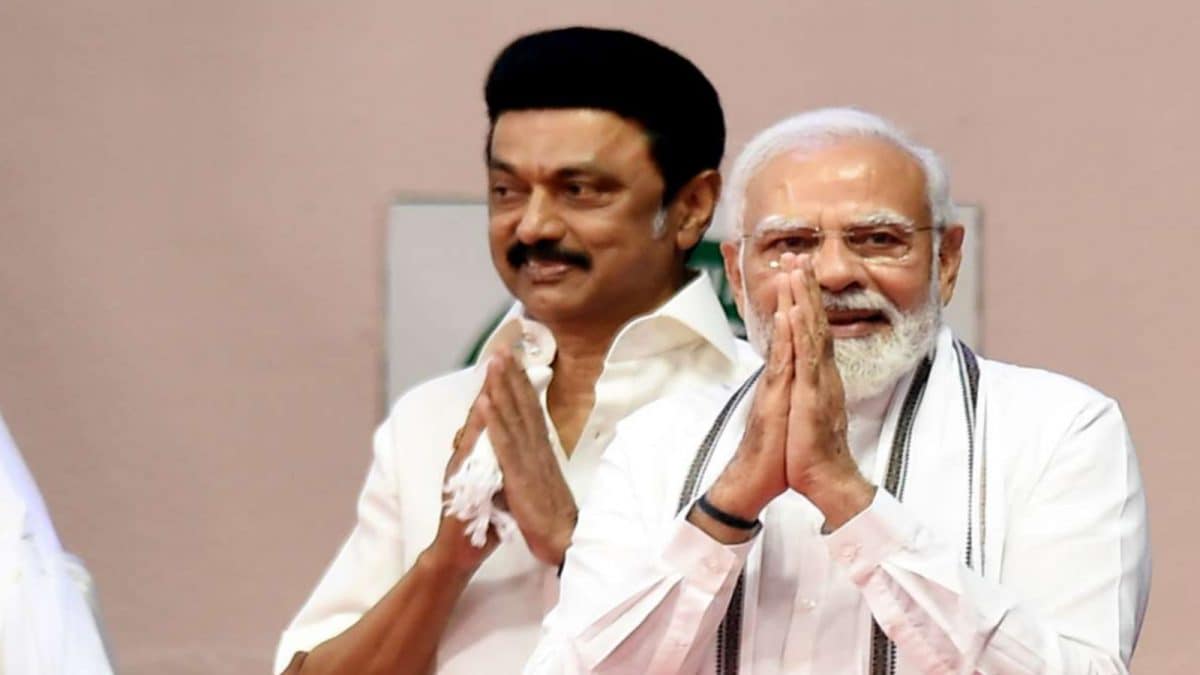Last Updated:
As the tussle between the Centre and states like Tamil Nadu intensifies, will the north-south divide in Indian politics widen even more?
Southern states like Tamil Nadu, Kerala, and Karnataka fear that they will lose political power and heft, even though they’ve managed to slow their population growth. File pic/PTI
It’s the north vs south battle—but this time, it’s about representation in India’s Parliament, and “imposition” of Hindi!
First things first: will delimitation of seats in the Lok Sabha change India’s political landscape? Will it be a win for the north and a loss for the south? And are the southern parties playing politics by raising the bogey of Hindi imposition?
To start off, let’s deep-dive into the issue of delimitation.
Delimitation debate
Picture this: for the last half-century, the number of Lok Sabha seats has remained frozen, at 543. Yes, that’s right – frozen since 1976. Now, some might say, “Why mess with it?”
The reality is that India’s population has undergone a dramatic shift.
Northern states, like Uttar Pradesh, Bihar, and Madhya Pradesh, have seen their populations explode. Meanwhile, the southern states, including Tamil Nadu, Kerala, Karnataka, Andhra Pradesh, and Telangana, have made incredible strides in slowing down their population growth.
But here’s the catch: in a country where population growth is so critical to democracy, the north and south are fighting over how seats in Parliament should be allocated. This is a delimitation battle like never before.
Here is what the Tamil Nadu chief minister MK Stalin said while calling an all-party meeting on the issue on March 5.
‘We, in the south, have done our part. We’ve controlled our population, focused on healthcare, and family planning. But now, the Centre is looking to reward states that haven’t been as successful. This isn’t just unfair—it’s a betrayal of our efforts. We won’t let our voice be drowned out!” he said.
These are powerful words. And they’re not just coming from MK Stalin.
The entire southern bloc is feeling the heat. Telangana chief minister A Revanth Reddy has thrown his weight behind Stalin on the issue.
Tamil Nadu’s fear? If the delimitation exercise is based on population growth, its share of Lok Sabha seats overall will shrink – despite their economic contributions to the country. Right now, Tamil Nadu has 39 seats. But Bihar has 40, even though Tamil Nadu’s population growth has been slower.
Look at these numbers: Uttar Pradesh’s population has grown by more than 16 crore since 1971, yet its seats haven’t changed. Bihar? 13 crore more people. But in the south, Tamil Nadu, Kerala, and Karnataka have all slowed their growth – they’re doing the hard work of family planning, but it seems like that’s going to cost them politically.
In all this, it is important to respect the principle of one person, one vote. If seat distribution is kept unchanged across states as it has been over the last 50 years, it will only worsen the already skewed representation across India’s states.
For example, an MP in UP caters to nearly 3 million residents compared to less than 2 million in southern states. Is it fair to a person living in UP or Bihar to continue with the same arrangement that was there 50 years ago?
Also, labour from northern states has a big role in the economic development of southern states. The economic progression of the south has helped it lower population growth rates.
But here’s the big question: should states that have been more responsible with their population be penalised for their success? KT Rama Rao from Telangana doesn’t think so. He’s been vocal about this issue, calling for the delimitation to also consider a state’s economic contribution—and not just the population. After all, the south contributes a huge chunk to India’s GDP, yet it feels like it is getting the short end of the stick in tax allocations and representation.
KTR says, “We are nation-builders, contributing massively to India’s GDP. Yet, we are left underrepresented. This isn’t just about population numbers—it’s about fairness. Southern states should not be penalised for doing what’s right for the nation.”
Here’s the twist—southern states argue that delimitation should also account for how much each state contributes fiscally to the country. Southern states are home to India’s major economic hubs, like Bengaluru, Chennai, Hyderabad, and Kochi. But guess what? They pay more taxes than they get back. And in the national debate, they fear their voice will shrink as well.
Census slowdown
Now, the Centre is caught in a bind. The delimitation exercise was meant to happen after the next Census post 2026—so after the 2031 Census.
But the 2021 Census has been delayed by five years. Why? Some say it’s deliberate, so the Centre can rush through the process in 2026 and give an advantage to the north. The argument goes that by delaying the Census, the Centre gets to base the delimitation on current population figures, which could hurt the south.
Amit Shah, the union home minister, has assured that there will be no pro-rata reduction for the southern states. He in fact has assured that all states will see an increase in their seats, and the southern states would get their rightful share in the increase too.
But his statements seem to have only created more confusion. Siddaramaiah, the CM of Karnataka, says that this only adds to the uncertainty for states like Tamil Nadu, Telangana, and Kerala.
The Karnataka CM says, “The Centre’s statements are ambiguous. If delimitation is going to be based on the latest population numbers, we will lose seats. If they stick to current seat allocation, it will still be unfair. We need clarity.”
The new Lok Sabha chamber is set to house 888 MPs, but the real question is: who gets to fill those seats?
Southern states like Tamil Nadu, Kerala, and Karnataka fear that they will lose political power and heft, even though they’ve managed to slow their population growth.
Southern states feel that an increase in seats for them would be moderate, while it would be astronomical for northern states—putting the BJP at an advantage as it has a wide base in the north. The Congress too has performed poorly in the north since the BJP’s rise here under Narendra Modi.
All would depend on the formula that the Delimitation Commission, once set up, arrives at to determine the base average population. This is the number of people that every MP on average represents, and the idea is that the population in each constituency be tightly grouped around this average.
This could be tricky and the delimitation commission, which will have representation from all parties, has a tough task and could see political fireworks.
So, what’s the solution? Can the government craft a delimitation strategy that balances the need for fair representation without penalising states for their demographic management?
And more importantly, can the Centre show statesmanship and finally end the delayed Census saga, which is linked not just to delimitation but also to women’s reservation implementation?
Will the north-south divide in Indian politics widen even more? Or will this delimitation exercise be the moment that India finally gets fairer representation for all its citizens?
One thing is clear: southern states are not backing down, and northern states would want to correct what some say is a half-a-century-long anomaly. As this saga unfolds, it’s not just about population—it’s about justice and fair play in India’s democracy.
In plain language
Now, let’s talk about the second theatre of the north-south War—Hindi!
The language war in Tamil Nadu isn’t just about words—it’s about identity, pride, and a fierce 80-year-old resistance. This isn’t some new conflict either. For Tamil Nadu, rejecting the imposition of Hindi is deeply rooted in the state’s DNA. Fast forward to today, and that same spirit is alive and well.
Enter the National Education Policy (NEP) 2020. Now, this policy doesn’t flat-out demand Hindi be shoved down Tamil throats—it talks about imparting education in the mother tongue (which, in Tamil Nadu’s case, is obviously Tamil).
But, and here’s the catch, the NEP also recommends a three-language formula. In theory, that means Tamil students might have to pick up Hindi as a third language, though the NEP nowhere says it. Cue the alarms in Tamil Nadu. They see this as the same old story: Hindi imposition in a shiny new package.
This isn’t just about language—it’s politics with a capital P. On one side, you’ve got the BJP-led central government, which views Hindi as the unifier of India. For them, the three-language formula is essential for a national identity.
But in Tamil Nadu, it’s seen as an attack on their culture. K Annamalai, the BJP’s state chief, calls Tamil Nadu’s two-language policy obsolete and wants to replace it with the NEP. He’s even kicked off a signature campaign to push the policy through. To him, it’s about modernising education and keeping up with the world.
But then, you’ve got the DMK-led state government, with chief minister MK Stalin at the helm, standing firm against what they view as a dangerous erosion of their cultural autonomy. Stalin warns of a “language war” if the NEP’s three-language policy is forced upon the state. For them, this isn’t just about textbooks and classrooms—it’s a battle to preserve the very fabric of Tamil identity.
And then, just to make things more tense, the central government drops a bombshell: no funds for Tamil Nadu’s education system under the Samagra Shiksha Abhiyaan unless they comply with the NEP.
Union minister Dharmendra Pradhan calls it an “imaginary fight” from Stalin—accusing him of using the language issue to cover up his state’s governance challenges. It’s a classic tug-of-war: the state wants more freedom, and the Centre is using the financial carrot and stick to get its way.
For many in the BJP, it’s about modernisation and creating a more cohesive India, while for Tamil Nadu, it feels like another battle to preserve what makes them unique.
What now? Well, the fight continues, and both sides are digging in. The central government wants its NEP implemented across the board, but Tamil Nadu isn’t backing down. The stage is set for a fierce language war—and it’s one that’s about much more than just how we learn to speak.






